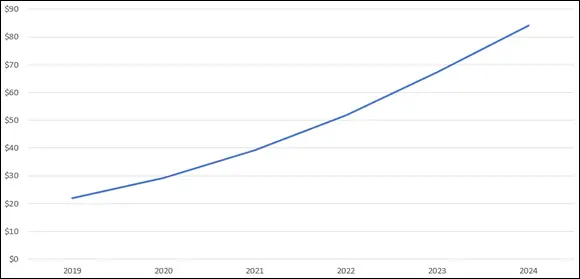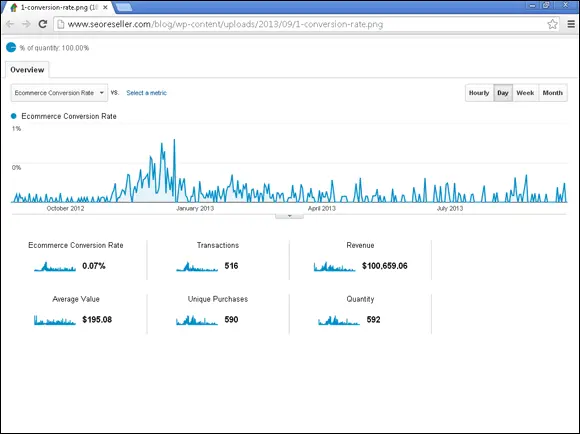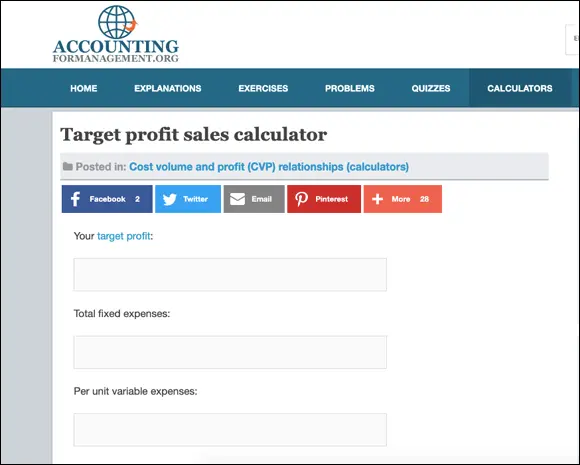If you sell online, your storefront should provide ways for you to slice and dice sales to obtain crucial data. However, if your sales come from services, from a brick-and-mortar store, or from large contractual purchases, you probably need to obtain revenue statistics from financial or other external records to plug into your ROI calculation.
 If you manage a bricks-and-clicks operation, you may want to integrate your online and offline operations by selecting e-commerce software from the vendor who provides the point-of-sales (POS) package for your cash registers. That software may already be integrated with your inventory control and accounting packages.
If you manage a bricks-and-clicks operation, you may want to integrate your online and offline operations by selecting e-commerce software from the vendor who provides the point-of-sales (POS) package for your cash registers. That software may already be integrated with your inventory control and accounting packages.

Source: www.statista.com/statistics/277045/us-social-commerce-revenue-forecast/#:~:text=In%202019%2C%20social%20commerce%20sales,U.S.%20retail%20e%2Dcommerce%20sales.
FIGURE 2-2:Social commerce revenues will grow rapidly over the next five years (in billions).
Just as with performance metrics, you should be able to acquire certain key performance indicators (KPI) for sales by using storefront statistics. Confirm that you can access this data before purchasing your e-commerce package:
You should be able to determine how often customers buy (number of transactions per month), how many new customers you acquire (reach), and how much they spend per transaction (yield).
Look for sales reports by average dollar amount as well as by number of sales. Plugging average numbers into an ROI calculation is easier, and the results are close enough as long as the inputs are consistent.
You should be able to find order totals for any specified timeframe so that you can track sales tied to promotions, marketing activities, and sale announcements.
Look for the capability to sort sales by new and repeat customers; to allow for future, personalized offers; and to distinguish numbers for CAC.
Your sales statistics should include a conversion funnel (as described in Chapter 1of this minibook). Try to trace the path upstream so that you can identify sales initiated from social media.
Check that data can be exported to a spreadsheet.
Make sure that you can collect statistics on the use of promotion codes by number and dollar value so that you can decide which promotions are the most successful.
Having store reports that break down sales by product is helpful. Sometimes called a product tree, this report shows which products are selling by SKU (stock keeping unit) and category.
Table 2-2lists some storefront options that integrate with social media and offer sales analytics. Unfortunately, not all third-party storefront solutions offer ideal tracking. Many storefront solutions use Google Analytics, shown in Figure 2-3, to track transactions.
TABLE 2-2Social Media Store Solutions Offering Sales Statistics
| Name |
URL |
Type of Sales Stats Available |
| Google Analytics ECommerce Tracking |
https://developers.google.com/analytics/devguides/collection/analyticsjs |
Google Analytics for e-commerce. |
| Ecwid |
www.ecwid.com/payvment |
Integrated storefront that works on social media, mobile, and blog sites. |
| ProductCart |
www.productcart.com |
Google Analytics integration at the product level. |
| Shopify |
www.shopify.com |
Offers its own reports as well as integration with Google Analytics, Facebook pixel, and Pinterest tag. |
| BigCommerce |
www.bigcommerce.com |
Social commerce platform that works with Instagram, Facebook, Pinterest, as well as eBay, Amazon, and Google Shopping. |
| 3dcart |
www.3dcart.com |
E-commerce platform that is a one-stop shop for creating an online store. It connects with Facebook, eBay, Amazon, and other channels. |
As the value of social media for generating sales has grown, many social media channels have improved their tracking options for sales completed on a website. In addition to Facebook’s long-offered conversion pixel, Pinterest now has a tag code tool and Twitter generates conversion code for placement on a “thank-you” page at the conclusion of a purchase.
If you created alternative SKUs for products sold by way of social media for tracking, be sure to merge them into the same category of your product tree. Using multiple SKUs isn’t recommended if your storefront solution includes inventory control.
You can input the numbers from your social media sales metrics into a sales calculator to forecast unit sales needed to meet your goals. Figure 2-4 shows a calculator from AccountingforManagement.org at www.accountingformanagement.org/target-profit-sales-calculator . Users enter values for the variables in the fields at the top of the image and click Calculate; different forecasts appear below the fields.

Courtesy of SEOReseller.com
FIGURE 2-3:Typical e-commerce statistics available on Google Analytics.

Courtesy of AccountingforManagement.org
FIGURE 2-4:Target Profit Sales calculator from AccountingforManagement.org.
Often, your social media or web presence generates leads instead of, or in addition to, sales. If your sales process dictates that some or all sales are closed offline, you need a way to track leads from initiation to conversion. Customer relationship management (CRM) software helps you track prospects, qualified leads, and customers in an organized way. A simple database might allow different managers, salespeople, and support personnel to share a client’s concerns or track the client’s steps within the selling cycle.
The process of CRM and lead management may also include qualifying and nurturing leads, managing marketing campaigns, building relationships, and providing service, all while helping to maximize profits. Table 2-3lists some lead-monitoring and CRM software options.
TABLE 2-3Lead-Monitoring and CRM Software
| Name |
URL |
What You Can Do |
Cost |
| HubSpot |
http://offers.hubspot.com/free-trial |
All-in-one software; manage inbound leads, lead generation, and more. |
Free 14-day trial; starts at $40 per month after free trial |
| Freshsales |
www.freshworks.com/freshsales-crm/?source=fworks&medium=referral&campaign=fworks_product_nav |
Lead scoring, phone, email, activity capture, and more. |
Free 14-day trial; starts at $19 per month after free trial |
| SplendidCRM |
www.splendidcrm.com/Store.aspx |
Install open source CRM software. |
Options range from free open source download to unlimited use for $960 per user |
 Although often thought of as the province of B2B companies offering high-ticket items with a long sales cycle, lead-tracking tools can help you segment existing and prospective customers, improve the percentage of leads that turn into clients, and build brand loyalty.
Although often thought of as the province of B2B companies offering high-ticket items with a long sales cycle, lead-tracking tools can help you segment existing and prospective customers, improve the percentage of leads that turn into clients, and build brand loyalty.
Читать дальше

 If you manage a bricks-and-clicks operation, you may want to integrate your online and offline operations by selecting e-commerce software from the vendor who provides the point-of-sales (POS) package for your cash registers. That software may already be integrated with your inventory control and accounting packages.
If you manage a bricks-and-clicks operation, you may want to integrate your online and offline operations by selecting e-commerce software from the vendor who provides the point-of-sales (POS) package for your cash registers. That software may already be integrated with your inventory control and accounting packages.


 Although often thought of as the province of B2B companies offering high-ticket items with a long sales cycle, lead-tracking tools can help you segment existing and prospective customers, improve the percentage of leads that turn into clients, and build brand loyalty.
Although often thought of as the province of B2B companies offering high-ticket items with a long sales cycle, lead-tracking tools can help you segment existing and prospective customers, improve the percentage of leads that turn into clients, and build brand loyalty.










